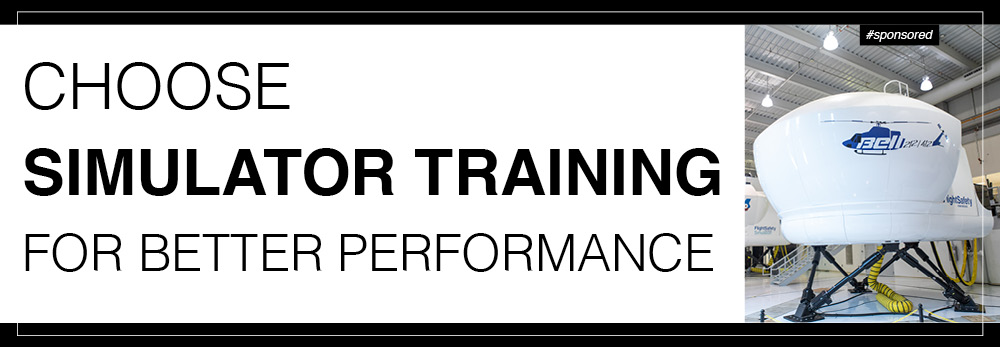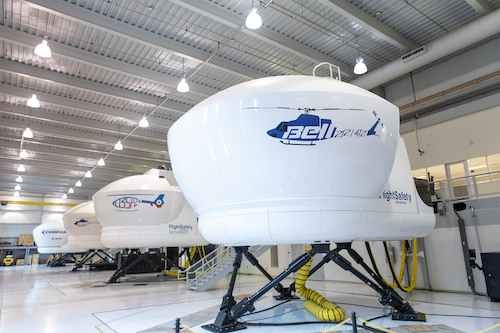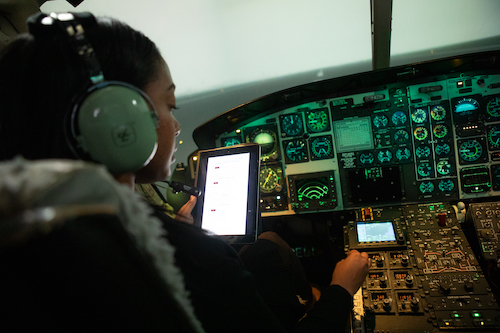|
Apr
10
2023
|
|
Posted 2 years 274 days ago ago by Admin
|
|

Skilled helicopter pilots know there’s no substitute for effective flight training. For the most impactful training, there’s only one decision that makes the most sense for its effectiveness, indirect costs and range of training, and that’s simulator training at FlightSafety International.
Fixed-wing pilots and the airlines have used simulator training to their advantage for years. While helicopter pilots have had the tools available to them, there has recently been a culture shift to simulator training over training in the aircraft, and for good reasons.
No matter the nature of the mission most frequently flown by your flight crews, training in a simulator makes sense. Compared with in-aircraft training, FlightSafety’s simulator training is superior in many ways, including:
- Effectiveness of instruction
- Overall safety
- Liability exposure
- Aircraft availability
- Wear and tear on the aircraft
- Costs
- Advanced technology

Creating the Right Environment
When training is done in-aircraft, you and the instructor must imagine certain conditions exist. What’s the weather? How are other aircraft impacting your flight? Are there certain conditions or air traffic delays which require specific training?
In every case, the simulator can create and replicate the exact conditions needed for the training objective. Abnormal and emergency events happen just as they would in the actual aircraft. No need to pretend, no need to substitute imagination for reality. You and your instructor can focus on the task at hand without distraction. Training in a simulator is more comprehensive and thorough than it could ever be in an actual aircraft.
Managing Safety
While the goal of training is to be a better and safer pilot in the future, there’s no need to expose you and your crew to unnecessary risks to achieve that. Training for emergency situations in the aircraft creates hazards that might prove dangerous to pilots of all skillsets.
Realistic scenarios force pilots to make split-seconds decisions, which should be handled in the safety of a simulator. The margin for error while practicing these procedures in the aircraft is minimal. Simulator or flight training device (FTD) training removes this potential danger. Consider the costs outside of the danger. Even minor accidents can damage the aircraft – far exceeding what you would have spent in a simulator.
In-aircraft training creates unnecessary exposure to incidents and accidents, which subjects your aircraft and crew to added risk. That can generate potential liability for the aircraft operator. Simulation training provides a safe, focused and realistic training environment for you and other operators.

Keeping the Aircraft Available
Helicopters that are used for inflight training are aircraft that are not in position to generate revenue. If your flight operations’ primary mission isn’t to support training, it’s a deficient use of the aircraft to use it in that regard.
Even slight damage to the aircraft during training can take it out of service while expensive repairs are completed.
Likewise, any additional use of a helicopter increases the need for routine maintenance, which training can exasperate. During in-aircraft training, pilots are more susceptible to have harder landings, and engine and system exceedances that can reduce the useful life of your aircraft and cause premature component replacement. Save your aircraft for its primary mission, which is not in-aircraft training.
Using simulator training encourages quick repetition of events and skills to build proficiency. Eliminate the high price of fuel from your decision as to whether it’s worth redoing scenarios. In a simulator, you have the ability to get it right and make sure you’re prepared for what’s out there with the simple push of a button to reset the scenario.

Realism without Compromise
One of the greatest advantages FlightSafety simulator training has over in-aircraft training is the technological advancements. You’re using the pinnacle of simulator technology – the FlightSafety Level D simulator – during your training. FlightSafety’s proprietary high-fidelity graphics and worldwide visual database put you in the perfect spot to master the mission, no matter where you’ll be flying.
It’s a big reason why FlightSafety is the factory-authorized training provider for major manufacturers such as Sikorsky, as well as supporting the U.S. Army through its mission at Flight School XXI to ensure mission readiness. FlightSafety works in close concert with the OEMs to keep courses that match their technology.
Most of its Level D simulators are also compatible for Night Vision Goggle training, offering an added level of realism and efficiency to your training profile; you will no longer have to wait for night fall or the perfect moon-lit or moonless night to complete your training. In FlightSafety Level D simulators, these environments can be created instantly 24/7/365.
The goal of any training should be to go beyond just checking boxes. Good training prepares you and builds confidence to handle the unexpected. Choose the equipment and methodology that’s focused solely on training for the optimal experience. FlightSafety trains you to stay sharp, fine tune, and always be prepared – for whatever the next flight throws at you – proficient is capable, prepared is unshakable.
#sponsor
READ MORE ROTOR PRO: https://justhelicopters.com/Magazine
WATCH ROTOR PRO YOUTUBE CHANNEL: https://buff.ly/3Md0T3y
You can also find us on
Instagram - https://www.instagram.com/rotorpro1
Facebook - https://www.facebook.com/rotorpro1
Twitter - https://twitter.com/justhelicopters
LinkedIn - https://www.linkedin.com/company/rotorpro1